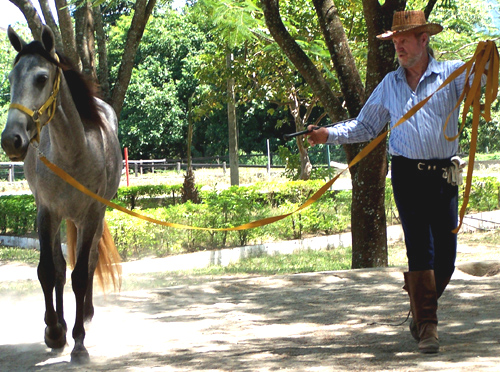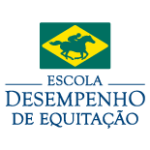- Classes and Clinics
- Escola Desempenho
Dressage
Dressage is simply the training of the horse to develop and use its body so that, even when mounted, it moves with fluidity, power and joy. It is the basis that is used to train the young horse and to prepare it for disciplines such as: jumping, advanced dressage, cross, mounted archery, working equitation, etc.
Preparing the horse to be ridden

This work begins with ground training and then continues with the mounted sequence, reinforced with more refined ground work.
We teach our horses in seven stages.
The horse learns and shows how, based on its natural reflexes, we must organize the “chain of conditioned reflexes of riding”. The success of the future relationship and interaction between horse and rider during riding will depend on the correct attitude, body language, sounds and gestures of the trainer. In the seventh stage, the horse is mounted and the commands from the ground are transferred upwards.

Riding in the Horse's Favor
We follow the concepts of the German Dressage Training Scale. In this way we teach our students to create a solid base of equestrian knowledge that allows them to improve in all disciplines and to ride in harmony with the horse.

Learn to Ride
Learning to ride is a multi-stage process that mirrors that of the horse. The rider’s first goal is to have an independent seat. Without this balance in movement, it is not possible to ride in favor of the horse.
To get there, the student first needs to know how to relax on the horse’s back, because tension creates a vicious circle… the horse becomes tense too. Once relaxed, the student needs to train their balance in the horse’s three gaits. This balance should come from the center of your body (psoas, iliopsoas and rectus abdominis muscles). Once you’re relaxed and balanced, comes the part that for some is the hardest: staying in the horse’s movement. In addition to these body aids, there are also voice aids and the use of whips and spurs.
From the independent seat, we can communicate with the horse through seat aids (small changes in weight to maintain or change the horse’s balance), leg aids (to encourage the horse and act on the hind legs) and reins (to control the horse’s pasterns).
To ride lightly and in favor of the horse, the student must learn how to coordinate the aids. Once the student knows how to do this very well, by interpreting the horse’s reactions well, he can influence the horse in a subtle and light way. For those observing the partnership, it seems as if everything is happening in harmony, as if they are watching a centaur.
We also encourage our students to seek out theoretical knowledge through books and articles and to observe good riders

Classes, Courses, Clinics and Competitions
The Desempenho School offers single classes and courses in:
Basic Riding (Beginners and Elementary)
Intermediate
Advanced
After finding out more about your riding experience, interests and goals, we can recommend a suitable course or a tailor-made package.
We also organize Clinics with guest instructors.
Through our Dressage and Jumping Team, our students have the opportunity to take part in competitions at state level (FEERJ).
Modalities, Classes and Clinics
Contact
- Estrada Antônio José, km 5, Faraó, Cachoeiras de Macacu - RJ
- +55 (21) 98156-0212 (Tim) +55 (21) 99765-8576
- escola@desempenho.esp.br
